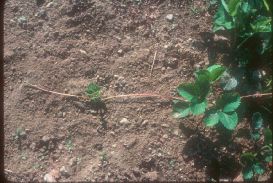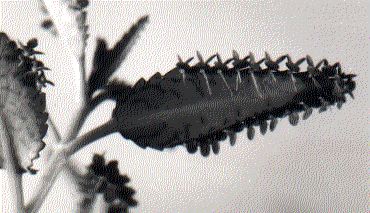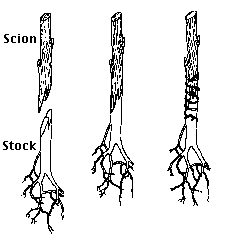| Index to this page |
Asexual reproduction is the formation of new individuals from the cell(s) of a single parent.
It is very common in plants; less so in animals.
In some species, stems arch over and take root at their tips, forming new plants.
The horizontal above-ground stems (called stolons) of the strawberry (shown here) produce new daughter plants at alternate nodes.
Underground stemsIrises and day lilies, for example, spread rapidly by the growth of their rhizomes.

Cuttings may be taken from the parent and rooted [More].

Grafting is widely used to propagate a desired variety of shrub or tree. All apple varieties, for example, are propagated this way.
Apple seeds are planted only for the root and stem system that grows from them. After a year's growth, most of the stem is removed and a twig (scion) taken from a mature plant of the desired variety is inserted in a notch in the cut stump (the stock). So long the cambiums of scion and stock are united and precautions are taken to prevent infection and drying out, the scion will grow. It will get all its water and minerals from the root system of the stock. However, the fruit that it will eventually produce with be identical (assuming that it is raised under similar environmental conditions) to the fruit of the tree from which the scion was taken.
The many races of Kentucky bluegrass growing in lawns across North America and the many races of blackberries are two examples of sterile hybrids that propagate successfully by apomixis.
Recently, an example of apomixis in gymnosperms was discovered (see Pichot, C., et al, in the 5 July 2001 issue of Nature). In a rare cypress, the pollen grains are diploid, not haploid, and can develop into an embryo when they land on either
Many valuable crop plants (e.g., corn) cannot be propagated by asexual methods like grafting.
Agricultural scientists would dearly love to convert these plants to apomixis: making embryos that are genetic clones of themselves rather than the product of sexual reproduction with its inevitable gene reshuffling. After 20 years of work, an apomictic corn (maize) has been produced, but it does not yet produce enough viable kernels to be useful commercially.
In some species, e.g., jellyfishes and many echinoderms, the buds break away and take up an independent existence.
In others, e.g., corals, the buds remain attached to the parent and the process results in colonies of animals.
Budding is also common among parasitic animals, e.g., tapeworms.| Link to two examples. |
In parthenogenesis ("virgin birth"), the females produce eggs, but these develop into young without ever being fertilized.
Parthenogenesis occurs in some fishes, several kinds of insects, and a few species of frogs and lizards. It does not normally occur in mammals because of their imprinted genes. However, using special manipulations to circumvent imprinting, laboratory mice have been produced by parthenogenesis. [Link]In a few nonmammalian species it is the only method of reproduction, but more commonly animals turn to parthenogenesis only at certain times. For example, aphids use parthenogenesis in the spring when they find themselves with ample food. Reproduction by parthenogenesis is more rapid that sexual reproduction, and the use of this mode of asexual reproduction permits the animals to quickly exploit the available resources.
Parthenogenesis is forced on some species of wasps when they become infected with bacteria (in the genus Wolbachia). Wolbachia can pass to a new generation through eggs, but not through sperm, so it is advantageous to the bacterium for females to be made rather that males.
In these wasps (as in honeybees),Treating the wasps with an antibiotic kills off the bacteria and "cures" the parthenogenesis!
Apis mellifera capensisOccasionally worker honeybees develop ovaries and lay unfertilized eggs. Usually these are haploid, as you would expect, and develop into males. However, workers of the subspecies Apis mellifera capensis (the Cape honeybee) can lay unfertilized diploid eggs that develop into females (who continue the practice). The eggs are produced by meiosis, but then the polar body nucleus fuses with the egg nucleus restoring diploidy (2n). (The phenomenon is called automictic thelytoky.)
Perhaps the better question is: Why not?
After all, asexual reproduction would seem a more efficient way to reproduce and avoids all sorts of problems.
Perhaps sexual reproduction has kept in style because it provides a mechanism to weed out harmful mutations that arise in the population (through the recombination process of meiosis).
But there are many examples of populations that thrive without sex, at least while they live in a stable environment.
Perhaps it is the ability to adapt to a changing environment that has caused sex to remain the method of choice for most living things.
Evidence (from Goddard et al. in the 31 March 2005 issue of Nature):Budding yeast missing two genes essential for meiosis adapt less rapidly to growth under harsh conditions than an otherwise identical strain that can undergo genetic recombination. Under good conditions, both strains grow equally well.
An asexual population tends to be genetically static. Mutant alleles appear but remain forever associated with the particular alleles present in the rest of that genome. Even a beneficial mutation will be doomed to extinction if trapped along with genes that reduce the fitness of that population.
But with the genetic recombination provided by sex, new alleles can be shuffled into different combinations with all the other alleles available to the genome of that species. A beneficial mutation that first appears alongside harmful alleles can, with recombination, soon find itself in more fit genomes that will enable it to spread through a sexual population.
Evidence (from Rice and Chippindale in the 19 October 2001 issue of Science):Using experimental Drosophila populations, they found that a beneficial mutation introduced into chromosomes that can recombine did — over time — increase in frequency more rapidly than the same mutation introduced into chromosomes that could not recombine.
So sex provides a mechanism for testing new combinations of alleles for their possible usefulness to the phenotype:
Some organisms may still gain the benefits of genetic recombination while avoiding sex. Many mycorrhizal fungi use asexual reproduction only. However, at least two species have been shown to have multiple — similar — copies of the same gene; that is, are polyploid. Perhaps recombination between these (during mitosis?) enables these organisms to avoid the hazards of accumulating deleterious mutations. (See the paper by Pawlowska and Taylor in the 19 Feb 2004 issue of Nature.)
The speed with which parasites like bacteria and viruses can change their virulence may provide the strongest need for their hosts to have the ability to make new gene combinations. So sex may be virtually universal because of the never-ending need to keep up with changes in parasites.
Evidence:The idea that a constantly-changing environment, especially with respect to parasites, drives evolution is often called the Red Queen hypothesis. It comes from Lewis Carroll's book Through the Looking Glass, where the Red Queen says "Now here, you see, it takes all the running you can do to keep in the same place".
| Welcome&Next Search |